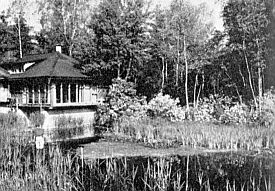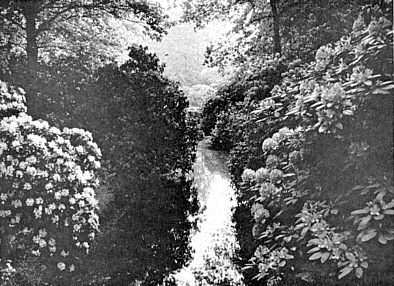Some Rhododendron Gardens in Germany,
Holland and Switzerland
Herbert Hechenbleikner
UNCC Station, Charlotte, North Carolina
|
|||

|

|
||
|
FIG. 96. Planting of
R. yakushimanum
hybrids at Bremen Rhododendron Park. |
FIG. 97. Selegar Moor. | ||
Upon arriving in Germany during the last week in May, 1972, my first visit was to Dietrich Hobbie's well known rhododendron garden and nursery at Linswege near Oldenburg, which is about a 45-minute ride from Bremen. Here I was received in a most courteous and friendly manner by Herr Hobbie and his son-in-law Friedrich Durre. The main garden is over forty years old and is set among high pines (
P. sylvestris
) and a few scattered oaks (
Q. robur
). Here are numerous woodland paths bordered by 5-15 foot azaleas and rhododendrons, both species and hybrids, some of the latter being of Herr Hobbie's own crosses. Among these many hybrids made over the years are some very fine yellows as well as other colors, especially pinks and reds. In the open places various conifers are set out as companion plants. At the Moor Garden the hybrids are set out in a canalized peat bog which contains 9-12 feet thickness of peat. The ground here when cleared of small native trees and scattered grass develops a heavy cover of various mosses, especially
Polytrichum
with
Sphagnum
in the moister spots together with heather and
Vaccinium
. This is such a favorable substrate that many of the naturally scattered seeds germinate and there are occasional seedlings, especially along the sides of the 18 - 24 inch deep drainage ditches. In many places there are large patches of
Cornus canadensis
and
Trientalis orientalis
brought over from Canada many years ago.
A two hour visit to the Bremen Rhododendron Park under the guidance of the director, Dr. Lothar Heft and in the company of Herr Durre, was most enjoyable. There were literally hundreds of azaleas, both hybrids and species. Some of the many rhododendrons were 15 - 20 feet high and there are, in the propagating beds, young plants of all ages. These beds contained several hundred rhododendron crosses made by Dr. Heft with many of them being
R. yakushimanum
hybrids, some of which had been back crossed and showed great promise. Beautiful whites and pinks with large trusses were seen on these plants. A most interesting item seen in this fine park was the new 5000 square foot glass house, nearly 50 feet high, built for the express purpose of growing tropical and semi-tropical species to be admired and for use in hybridizing. There are already more than 250 plants started with some apparently on the way to becoming fine specimen plants despite the newness of the structure, finished only months ago.
After the meeting of the German Rhododendron Society (Deutsche Rhododendron Gesellschaft) on May 27, most of the group of 88 members present went on a three day chartered bus trip to Holland to see rhododendron and conifer gardens. Before leaving for Holland, however, we visited the beautifully designed and planted "Gruga Park" in Essen where the meeting was held. Here rhododendrons up to fifty years old are massed in large beds with individual plants fifteen to twenty feet high and almost as wide. Many
R. catawbiense
hybrids and clones are found there as well as in other gardens visited. Some of these are 'C. Grandiflorum', 'C. Boursalt', 'C. Album', 'Lees Dark Purple', 'Charles Dickens' and, of course, the handsome 'Cynthia.' Two of the most striking rhododendrons seen in the many gardens were 'Louis Pasteur' and 'Blue Bell'. In this garden are Exbury, Mollis Knap Hill and Ghent azaleas in abundance. These large flowered azaleas are often planted in large beds with the large-leaved rhododendrons and thus make a pleasant and beautiful contrast.
One of the chief points of interest in Holland was the well-known "Floriade" in Amsterdam. For a person with wide horticultural interests this is a very worth while display of flowering plants, mostly herbaceous, of all kinds. The display area maintained by some of Holland's leading nurserymen are interesting and show fine examples of azaleas and rhododendrons as well as other plants. There is a small but very nice planting of rhododendrons and azaleas in the "Rhododendron Valley".
In many test green houses are the finest examples available of roses, gladoli, various lilies and many other hot house and garden plants. Although there were beds with thousands of tulips scattered throughout the large area of many acres, during our visit on May 30th, most of them had finished blooming and the gardeners were pulling them out of the rich soil with both hands.
The famous conifer garden, "Gimborn" at Doorn was most impressive with the pale green new growth weaving a tapestry against the dark green of the old growth. Other arboreta visited featuring mainly conifers were "Belmonte" in Wagenningen, "Trompenburg" near Rotterdam and the "Pineturn Blijdenstein" near Hilversum.
Upon arriving in Zurich, Switzerland I found my friend's rhododendron garden, Seleger Moor, was at its peak. This, the finest rhododendron and azalea garden in Switzerland, is situated in 15 acres of former peat bog which had been partially drained. The land was bought cheaply two decades ago because it was in the midst of agricultural lands and was considered unfit for anything. The winding paths are bordered by several thousand rhododendrons and azaleas, mostly hybrids. As ground cover there are literally thousands of
Cornus canadensis, Tiarella
sp., various ferns, including
Adiantum podatum
, and
Gaultheria
, etc. The beginnings of many of these plants were brought over from Alaska and Canada in earlier years when Herr Seleger went to those places for fishing and botanizing. In many places there are dozens of even hundreds of
Primula japonica
in three colors. The mixture of evergreen trees and shrubs, lily pond and white birches scattered throughout the area makes a most pleasing and harmonious scene. On the second day of my brief visit, a group of a dozen Swiss women, in old-fashioned native costume came to the garden to sing. The hundreds of visitors (1700 in two days) thoroughly enjoyed seeing and hearing these ladies. They left in mid-afternoon in a hack drawn by four horses with a coachman's assistant playing an accordion.
At various inconspicuous places throughout Seleger Moor are seen beds of young rhododendrons and azaleas which are being grown to sell and to plant the new areas of the Moor. Seleger plans to almost double the size of the Moor within the next few years and to build a considerable portion of it around a new lake of several acres. What impressed me most about the place other than the beauty and taste with which it was put together over a period of 15 years, was the ideal nature of the soil which was peaty in certain areas, sandy in others and often a mixture of the two types. The Ericaceae and related plants liking an acid soil seemed to grow like weeds. Despite this Robert Seleger is attempting, among other hybridizing efforts, to produce cold resistant, large flowered rhododendrons which will be capable of thriving in neutral or even slightly alkaline soils so he can introduce these plants into areas of Switzerland where they cannot now be successfully grown.
In conclusion, one cannot write about the rhododendron gardens of central Europe without mentioning the wonderful aroma that greets every visitor. Most of this scent is produced by
R. luteum
and some of the various fragrant hybrid azaleas found in all these gardens and parks. The combination of beautiful scenery and delightful fragrance will long remain in my memory.
